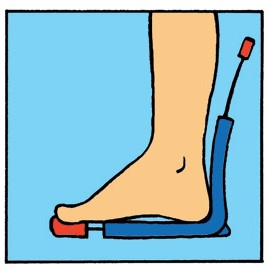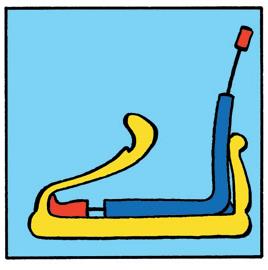Objednávky expedujeme do 18. 12. 2025, následně opět od 5. 1. 2026. Děkujeme za pochopení. ×
Objednávky expedujeme do 18. 12. 2025, následně opět od 5. 1. 2026. Děkujeme za pochopení. ×
HOW TO CHOOSE THE RIGHT SHOE SIZE
The human foot is a very complex unit. We can also state without embarrassment that each foot is original and is different for each individual. And the diversity is really very big. When choosing the right size of footwear for a child, this task is very often complicated by the fact that the child does not cooperate when trying on shoes or we cannot fully rely on his information. Therefore, when looking for a well-fitting shoe, it is necessary to correctly measure, examine and verify. There are really a lot of parameters to choose from. We now want to try to help you at least with the correct procedure for choosing the length of your shoes.
It is important to buy new shoes for the child in time, as soon as it is needed. Along with the growth of the feet it applies that- the smaller the child, the more couples per year you need. Foot damage occurs if we wear short shoes permanently. To prevent permanent damage to your child's feet, it is important to measure the size of their feet and shoes at the same time. Nowadays, there are several types of size markings on the markets and it is not possible to rely on the size that is shown on the shoes. Therefore, it can easily happen that the size of the shoes does not match the size of the foot. It is therefore necessary to be able to correctly measure not only the size of the foot, but also the shoes. The PLUS 12 meter will help you with this. This meter is intended not only for children, but also for adults.
First, we'll list the 3 most popular methods for finding shoe size, and we'll explain why they don't work:
1. Ask the child - the child's nervous system is still developing, so this method basically cannot work. Children have a reduced level of sensitivity to pressure and pain, so they cannot confirm with certainty that their shoes will not fit. The fact that children wear mostly short shoes can cause them to get used to it, and therefore they even label very small shoes as satisfactory.
2. Heel play - it is tested whether one finger can be inserted between the child's heel and shoes. This method would be ingenious, but children "roll" their toes in this way and thus move the foot a little forward to make room for the toe. So it looks like the shoes fit.
3. To determine the length of the shoe, place the foot on the sole. However, to find out if the shoes are suitable, we also need to know the inner length of the shoes. Therefore, this method does not produce any reasonable result, as it is based on the length of the outer side of the shoe and not on the inner one.
We consider all of the above methods to be insufficient and inappropriate. We would like to offer you the method of choosing the size as we consider it most suitable in our experience.
HOW TO PROCEED CORRECTLY WHEN CHOOSING THE SIZE OF SHOES?
1. Determine the current maximum length of the foot by placing the child against a straight wall so that the heel lightly touches this wall. At the end of the longest toe (usually the first), we run a perpendicular to the floor and mark the point thus determined. The distance between this detected point and the wall is the determined foot length, which we need for our purpose (see photo below).
.jpg)
2. For all types and sizes of FARE footwear, the information INNER LENGTH OF FOOTWEAR is listed on www.fare.cz. However, it is very useful to know what this information means and how it was obtained so that we can handle it correctly - see the photo below:
.jpg)
From the above, it is clear that we cannot follow the length of the insole, which on one hand in the front part does not reach perfectly to the front wall and especially at the back does not count the heel arch at all. It is also necessary to take into account the contour of the front part of the foot and compare whether it at least approximately corresponds to the observed shape of the shoe.
If we measured well, then it is also necessary to choose the right size of excess, of which the shoe must be longer inside. We choose the excess in the range of 8-14 mm, depending on the circumstances. The excess can be defined as a reserve space for the movement of the foot during each step and also during the day as the foot increases in volume. It is also a reserve for socks and especially for foot growth throughout the use of these shoes.
In this context, we would like to remind you that the final shape of the shoe is determined by the shape of the mould (hoof) on which the shoe is made. Therefore, it is desirable to rely on the fact that the outer dimensions of the hoof are identical to the inner dimensions of the shoe. For this simple reason, it is necessary to rely on the FARE manufacturer's data provided for individual shoe items. We believe that all other methods of determining the inner length of shoes are less accurate.
First of all,we have to keep in mind that we must always find out the current length of each foot and compare it accordingly with the inner length of the wanted shoes.
MEASURING INSTRUMENT PLUS 12
The Plus 12 measuring instrument is also a good helper when choosing the right shoe size, which allows quick orientation when comparing the size of the foot and the chosen shoe. HOWEVER, THIS METHOD CANNOT BE COMBINED WITH A METHOD THAT FARE PREFERRES AND IS DESCRIBED ABOVE.
The Plus 12 measuring instrument is an assistant that should not be missing in serious children's shoe stores or in any household - it is necessary for children to check the size of their shoes on an ongoing basis, as in some growth stages children grow three feet a year. If your child likes a picture on their shoes, it is hard to expect them to objectively tell us one day: "I have small shoes."
Measurement procedure with Plus 12:
Foot length:
Pull out “Plus 12“ and measure both barefoot, or in thin socks children´s feet. Read the measured value in millimeters (which means leg length + 12 mm required).

Shoe length:
Insert "Plus 12" into the shoe and pull it out. Read the value measured in millimeters – which means inner length of shoes (listed on our e-shop for each product in the description).

Result:
If both values are the same, the excess is 12 mm. The shoes are suitable.
You can order the “ Plus 12“ HERE.
How often should the length of the shoes be checked?
The child's foot grows very quickly, changing in length, width and proportions. The foot of a small child grows on average 15 to 18 mm per year, at older children 8 to 12 mm. This means that at the age of 2-3, children need 2 to 3 shoe sizes per year, at the preschool age 2 shoe sizes and at the school age 2 to 3 shoe sizes per year.
|
Age |
Checking recommended |
|
1-3 |
every three months |
|
3-6 |
every four months |
|
6-10 |
every five months |
If about 98 % of children are born with healthy feet, then there is nothing in the way why this could be the case in adulthood.
The responsibility lies with us - children's feet need many years for their development to end and for their bones, muscles and tissues to be stable and yet mobile. The better we take care of them during those first years, the more they are armed for the future. For all of us, walking, running and jumping are taken for granted, assuming that our feet just "work".
Give your children a chance to live with this for granted - give them a variety of movement and suitable footwear!
Copyright © 2025 Designed by WEBOO